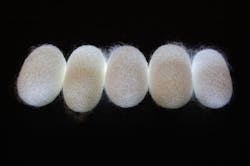Purdue researchers have shown how the architecture of a silkworm’s fibers cause “Anderson localization of light,” a discovery that could lead to various innovations, a better understanding of light transport and heat transfer, and the creation of new synthetic materials. The phenomenon, named after Nobel laureate Philip Anderson, involves electrons brought to a complete halt in materials due to their “scattering and defects.”
The architecture of the extremely small silk fibers can confine light,” a trait that be exploited in innovations that harness light for new types of medical therapies and biosensing. This light-confinement effect in biological and natural tissue was unexpected.
Various research organizations have created synthetic “metamaterials” which can ultra-efficiently control light. However, metamaterials are limited in that they are often difficult to scale up for commercial production. Because silk’s architecture is “disordered”—in contrast to meticulously designed periodic structures—the findings suggest a strategy to produce metamaterials which are less expensive to fabricate and manufacture, and easier to scale up for industry.
New research suggests fibers from a silkworm’s cocoon may represent “natural metamaterials,” a discovery with various technological and scientific implications. (Purdue University image/Young Kim)
Anderson localization of light is extremely challenging, yet scientists know it can be done using irregular, disordered nanostructures to create highly packed nanomaterials for strong light scattering, just as a silkworm produces a silk fiber and spins a cocoon shell in nature.
Silk fibers are 10 to 20 microns in diameter and contain thousands of tiny light-scattering nanofibrils, each around 100 nanometers wide. For perspective, a human hair is roughly 100 microns in diameter. Silk fibers have numerous “scattering centers” inside. Anderson localization arises from this light scattering due to disorder in the nanostructure.
For Anderson localization to take place, there must be both scattering and interference between scattered light waves. Densely packed irregular nanostructures cause light waves to interfere with each other, sometimes in destructive and sometimes in constructive ways. If constructive, the light is intensified and it forms a high energy inside the disordered media.
Purdue postdoctoral research associate Seung Ho Choi, at left, works with professor Young Kim to prepare a sample for analysis. (Purdue University image/Erin Easterling)
The small size and roughly parallel arrangement of silkworm nanofibrils facilitate the effect. The scattering power is maximized when there are many scattering centers and when their size is comparable to the wavelength of the light, both criteria found in the silk fibers.
Whereas commercial optical fibers must be specially engineered with a reflective coating, or cladding, to confine light, silk fibers handle this task naturally due to Anderson localization, which creates “modes” that make confinement of light possible without carefully engineered periodic structures. Instead, the same confinement is possible with disordered, more random designs.
The researchers found that most light transmission disappears in the silk surface. However, counterintuitively, in a small area the energy is confined and transmitted through localized modes, a unique pathway for energy flow.
Although biological structures such as silk diffuse light, other natural materials with similar microstructures do not possess the localized modes that make Anderson localization possible.
Such a difference makes silk particularly interesting for radiative heat transfer. Silk has a high emissivity for infrared light—meaning it readily radiates heat, or infrared radiation—and it is a good reflector of solar light. Because the strong reflectivity (from Anderson localization) combines with the high emissivity of silk biomolecules in infrared radiation, silk radiates more heat than it absorbs, making it ideal for passive, or “self-cooling.”
You may have heard that silk underwear can keep you cooler in summertime and warmer in winter. This research lays out the basic mechanism behind this observation.



